
Glenn Denning, a professor of Professional Practice at Columbia University’s School of International and Public Affairs, directs a Master of Public Administration in Development Practice program and teaches a graduate course in Global Food Systems. He also serves as Senior Policy Advisor at the Sustainable Development Solutions Network, launched by UN Secretary-General Ban Ki-moon in August 2012, to mobilize scientific and technical expertise from academia, civil society, and the private sector in support of sustainable development.
Denning spent 18 years at the International Rice Research Institute (IRRI; 1980-98), starting out as a visiting associate field specialist and later serving in many other capacities and senior management positions. He has also worked at the World Agroforestry Centre in Kenya. Honored by the governments of Vietnam and Cambodia for his contributions to agriculture and rural development, Denning holds agricultural science degrees from the University of Queensland and a PhD from the University of Reading. He has an MPA from the Harvard Kennedy School.
[embedyt] http://www.youtube.com/watch?v=9t_hqzgE6yY[/embedyt]
Listen to Glenn Denning tell his amazing Cambodia story
While at IRRI, Denning was heavily involved in what he calls an “amazing story more people should know about because it is such a compelling example about how genetic conservation and human capacity are so critical.” It has to do with the follow-up to the horrendous genocide of the “Killing Fields” in Cambodia (1975-79). It illustrates the power of international collaboration and a commitment to inclusive and sustainable development. January 2016 marks the 30th anniversary of post-war involvement of IRRI in this remarkable episode in agricultural history. With funding from the Australian Agency for International Development (AusAid), the Cambodia-IRRI-Australia Project (CIAP) was ultimately created in 1987 to solidify the effort.
Coming to IRRI in 1980
How I got into IRRI is actually very similar to how I got into most places in my career—it’s serendipity, almost a random chance. I was working in Zamboanga del Sur, Mindanao in the southern Philippines on a big Australian rural development project. I’d been there about 3 years and was really looking to do something different after that. I was an agronomist and I had made some connections with IRRI while in the Philippines. A lot of the work that I was doing in Mindanao was inspired by the work of Hubert Zandstra who, at that time, was the head of the Cropping Systems Program at IRRI. I’d read about all his work in South America before he actually came to IRRI and truly admired him for the systems work that he had done there.
But it was another IRRI colleague, Dale Haws, a crop production specialist, who was in charge of Rice Production Training and Research. It was essentially the applied research part of IRRI, which did field trials all over the country, working very closely with the Philippine ministry of agriculture. We had conducted several field trials for Dale as part of our project in Zamboanga del Sur. Every now and then, maybe once every couple of months or so, Dale or one of his colleagues would come down and visit the trials. On one of these trips, Dale said to me, “I’m going on a sabbatical leave next year for 12 months. Is there any chance you might be interested in coming to IRRI just for a 12-month period, manage my office, conduct these farm trials?” First, I was blown away by the opportunity to work at IRRI—such an amazing, famous, successful organization—really was a great attraction; and also, to have a chance to work with Hubert Zandstra, the person I’d been following so closely over the years. So, I came up to IRRI for an interview.
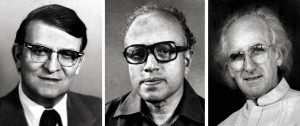
In those days, interviews were basically with the director general and he decided whether to hire you or not. So, I was to meet with Nyle Brady. On the day I arrived, I was told he was going to a meeting at the (U.S.) Ambassador’s residence so I could travel in the car with him from Los Baños to Manila. And so, I actually did my interview in the backseat of a car, while Dr. Brady, in his usual busy style, was signing memos and letters and various things. But we had a chat about what I’d been doing in the southern Philippines. He went to the Ambassador’s residence and I got dropped off at a hotel. [Editor’s note: Dr. Brady recently passed away on 24 November 2015.]
About a week or two later, I got a letter inviting me to come to IRRI for a year as a visiting associate field specialist. So, I came for a year and I stayed 18. One thing simply led to another. I worked very closely with Dale for a couple of years once he came back from the States. He eventually moved on and then M.S. Swaminathan arrived as director general in 1982 and he invited me to stay—but again, as a visiting scientist. At that point, I didn’t have a PhD and one of the things that Dr. Brady said when he brought me on was: “We’re glad to have you here but, of course, you can never become a scientist at IRRI until you have a PhD.” So, very early on I enrolled in a PhD program at Reading and worked on it part time for a few years. In 1984-85, I went to Reading, taking a personal sabbatical leave to finish up my PhD.
When I came back, Dr. Swaminathan converted the visiting appointment to a regular appointment, and that is when I started my regular career as an agronomist and scientist at IRRI, which lasted through to 1998. I started in the Training Center, which was then actually a combination of applied research and training. It had an outreach function to it, but it was primarily focused on the Philippines, not the whole international world of IRRI or the country programs that IRRI was very successfully working on in various parts of the world—Bangladesh, India, Nepal, Indonesia, Burma, as it was back then, Thailand, and even beyond.
On the IRRI international circuit
The Training Program eventually became the International Programs Management Office (IPMO) under Klaus Lampe when he became director general in 1988. As a management specialist himself, Dr. Lampe wanted IRRI’s international programs better organized with greater harmony across the programs and better coordination in terms of our support to those country programs. But even before then, I got interested in what we called the “country programs”. I went to Bhutan in 1983 on the first IRRI mission there and that started the relatively long-term collaboration in that country, with support from IDRC Canada. I went to Africa, making one of the earlier trips to Eastern and Southern Africa in the early ’80s (1984-85).
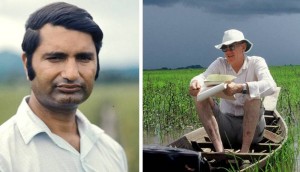
I started to get more and more interested in how IRRI’s work—the first-class research on varietal improvement, agronomy, engineering, etc.—could be relevant to other countries, particularly countries that had been bypassed by the Green Revolution for a number of reasons, including their environment—they were largely rainfed areas—and also because of conflict. And that’s what got me interested in the Indo-China region.
On to Cambodia
In January 1986, I was invited by Dr. Swaminathan to be part of the team that he was about to send to Cambodia, then known as Kampuchea. The team included [future World Food Prize winner] Gurdev Khush, Don Puckridge author of the uplifting Cambodian story, The Burning of the Rice, and myself. We spent about 10 days there. The visit had been requested by the Kampuchea Ministry of Agriculture at the urging of some NGOs working in Cambodia (including Catholic Relief Services). They were asking IRRI to return some of the seeds lost in the conflict that the Institute had in the genebank. There was much interest to have the rice industry up and running again after a long period of a great disruption to rice farming in the country. Lots of interesting things came out of that first mission as a result.
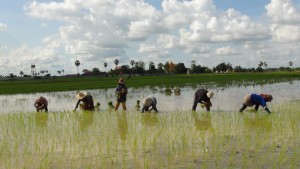
It’s a remarkable story that I wish more people knew about. It is such a compelling example about how genetic conservation is so critical, particularly for countries like Cambodia that are so reliant on agriculture and, in this case, so reliant on rice production. Cambodia has had quite a checkered history. Leading up to the end of the Vietnam War, the country was actually very productive—not necessarily high-yielding, but Cambodian farmers were generating surpluses of rice, leading up to about 1972-73, as the Vietnam War was coming to an end (and then), spilling over into Cambodia and Laos.
At one point in the late 1960s, the country had an area of around 2 ½ million hectares of rice. They were exporting small amounts to other parts of the world, particularly Africa. But as the war spilled over, there was a very strong anti-government movement going on in the rural areas. More and more Cambodians fled the countryside and made their way into Phnom Penh where they sought refuge.
The population of the city increased from about half a million to about 2 million people. At the same time, the area planted to rice decreased, decreased, and decreased. Large areas were affected by landmines as the conflict continued. So, Cambodia went from being a net rice surplus country to being a country that really couldn’t feed itself because everybody, or at least a big proportion of the population, was huddled into the capital city.
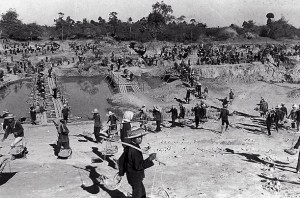
The Killing Fields begin
This leads us up to 1975. It was sometime in April that the Khmer Rouge actually took over the government. The nominal government disappeared and then we had a period of 3 ½, almost 4 years, of what’s known as “the killing fields”. The Khmer Rouge came in with a very unorthodox and brutal approach to development. Their view was to bring the whole country back to year zero. A way to do that in order to rid the country of all the ills that they saw had affected Cambodia over the years was to remove everybody from Phnom Penh. So, here we are. We have 2 million people essentially crowded into the city. Within a few weeks of the arrival of the Khmer Rouge, the population went down to 10,000. Imagine from 2 million to 10,000!
And so where did they send the people? They basically redistributed them all over the country—and not necessarily back to the places where they came from. Part of the ideology of the Khmer Rouge—and a very interesting one—was that they recognized that rice was important to Cambodia. But they wanted to modernize it and their idea of modernization was to irrigate rice somehow, loosely using the rice-growing concept of the old Angkor civilization, i.e., using large grids of irrigation canals. And so now you can sort of conjure up those images of the killing fields of very large numbers of essentially slave laborers out there digging ditches and trying to create irrigation canals.
At that time, the Chinese government supported the Khmer Rouge and so, there were Chinese advisers helping to introduce rice varieties from China to plant in these areas. But with hindsight, the engineering was extremely faulty; very little of that infrastructure ever led to any increase in irrigated rice production. The Khmer Rouge did not allow farmers to plant traditional deepwater rice like they used to around Tonlé Sap Lake. So, over that period, production went right down to less than a million tons—some statistics show even a half million tons—which was way less than needed to feed a population, notwithstanding the fact that the Khmer Rouge killed upwards of 2 million people over that period—one of the greatest genocides in human history.
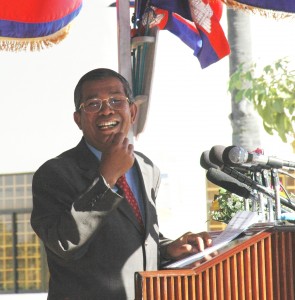
This went on for 3 ½ to 4 years. Finally, in January 1979, the Vietnamese came into Cambodia and installed a new government. They removed the Khmer Rouge partly because this government was launching attacks on Vietnam. Vietnam, of course, was a much more powerful force and, at that time, I think China had also reduced and eventually stopped supporting the Khmer Rouge because Vietnam had had its battles with China on the northern front as well. Anyway, Vietnam comes in and installs a new government led by Hun Sen, who is still the leader to this very day. That was 1979. NGOs began coming into the country, but slowly because for many years the Hun Sen government was considered illegitimate since it had been installed by an occupation force in which the Vietnamese had removed the Khmer Rouge.
Even when IRRI ultimately started working in Cambodia, the Khmer Rouge occupied a seat in the UN. So, there was no UN presence. In fact, all through this period during the early days that we worked there, the only governments that recognized the Hun Sen government were the Soviet Union and the Soviet Block countries, including Cuba—and one other country not in that sphere of influence—India.
Okay, so you had all Soviet Block but no Western governments recognizing the government in Cambodia, including Australia. Several years passed and then, finally, in 1986, Dr. Swaminathan received the invitation; we went into the country. Production had crept back up to about 2 million tons. Yields were still very low but there had been land area expansion and some of the security problems had been solved. It wasn’t completely secure. There were still landmines everywhere, which seriously affected agriculture, particularly rice farming. People, as well as animals, were being blown up by stepping on landmines. But anyway, there was a bit of an increase in rice production.
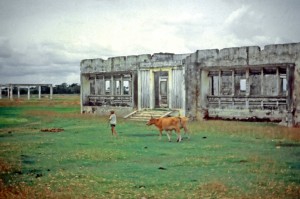
Shocking revelations
The IRRI team came in and we looked around and we were shocked, I would say, during that first mission. We couldn’t quite believe what we saw or heard. Not a lot of information came to the outside world during that 1975-79 Khmer Rouge period. But we started to talk to people, including the government officials. We talked to everyday folks. This was a hard-line communist government, by the way, that we were dealing with back then. But they did realize they had to feed their people. They had to increase production. They had that idea.
We started looking for anyone we can work with. In other countries, we’ve typically worked with their national research organization, which becomes our partner. We looked around Cambodia, all the buildings were destroyed; everything had been destroyed. We took some horrific photos from that era of what formerly were research institutions in the 1970s, totally flattened. There was nothing.
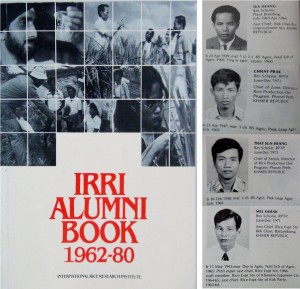
Where were the people? There were 400 trained agriculturists in the country prior to the war. After the war, there were 40. So, we had a literal decimation of the skilled agricultural expertise—people who would work in the extension ministry of agriculture, in the university, and so on. IRRI had this book with little photographs of all the IRRI trainees going back for years. One of the things we did before we went to Cambodia was to see who from Cambodia had done training courses at IRRI. Actually, there were only six faces with six names and we brought this with us. We started asking around. Of course, the first thing we tried to do was ask who had a connection to IRRI. We didn’t physically locate them, but we heard that only two of those six were still alive. So, the human resources and the physical infrastructure were wiped out. [Editor’s note: Since this interview was conducted, the last surviving trainee of those six—Thay Sun Heang, as he appeared in 1973 in IRRI’s Alumni book, and at right in the October 2015 photo belwo with Gene Hettel—was located. Watch for his interesting story in Rice Today].
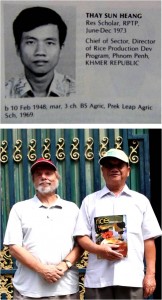
The varieties were lost as well because of all that dislocation and the fact that everybody moved to the countryside and then they went through this horrendous period of slave camps. People were so hungry they ate their rice seeds. So, the country basically lost so much of its rice genetic resources, which were essential in Cambodia, because 85% of the fields are rainfed. IRRI’s impact [in Asia] up to that point had been very much focused on the irrigated and favorable rainfed lowlands. It had had very little impact on harsher environments. All these traditional varieties in Cambodia had evolved under these harsher conditions and appeared to have been lost.
Re-introducing Cambodia’s traditional varieties
However, we have a very good news story that, luckily—probably more than luck!—very strategically, IRRI had sent in some collectors of traditional rice varieties in 1972-73 just before all the turmoil began. I believe more than 750 rice varieties were actually collected and stored in the IRRI genebank. So, we called up the folks in the genebank and we found out that yes, indeed, we’ve got all these varieties that were collected about 13 or 14 years previously! These varieties had lived safely in the genebank while the horrendous human genocide civil war was going on in Cambodia.
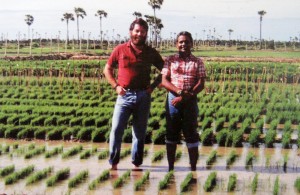
Over a period of several years [in the late 1980s], part of the IRRI program in Cambodia was actually to reintroduce those varieties. We had a couple of plant breeders there, Ram Chaudhary and Edwin Javier. They worked on the reintroduction of these traditional varieties. Farmers grabbed them and multiplied them. So, we had a two-pronged process to get these traditional varieties back in the places where they best fitted. The other part was where we had irrigated rice, perhaps 15% of the country, maybe a little more. So, we started to get state-of-the-art modern IR varieties in there, such as IR36 and so on. Not many good quality seeds of the new irrigated varieties had found their way into Cambodia. So, we had these two things going on at once. It wasn’t big to start with. It was slow improvement in production that has continued to this very day. So the varietal improvement part of it was very important.
The importance of human resources
I can’t underestimate the importance of human resources. As I mentioned, human capital had been decimated as a result of the war. People were either killed or fled as refugees and disappeared off the map as far as Cambodia was concerned. So, our major initial focus was on capacity building. This wasn’t easy because virtually nobody there spoke English.
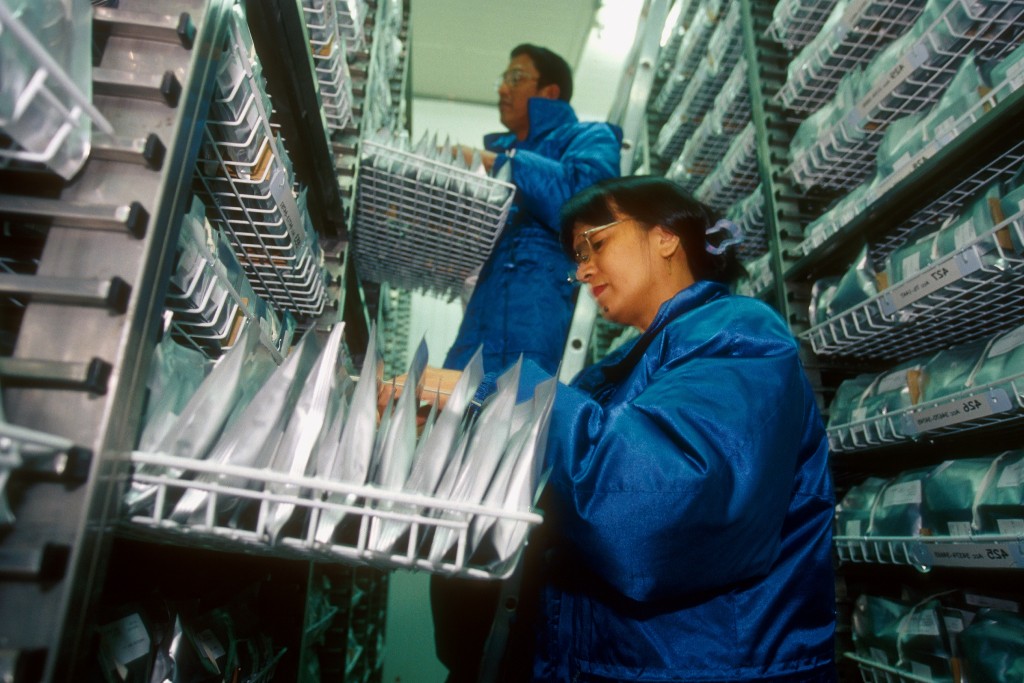
One of the first things we did was to bring a group of 13 Cambodians to IRRI sometime in 1987. This was the largest group of Cambodians ever to leave the country. Well, let’s say, ever to leave the country to go elsewhere than the Soviet Union or other parts of the world that were friendly with Cambodia at that time. We organized to bring them to IRRI for 5 months of training. We had a special rice production training course and everything had to be translated. We had a translator. Everything had to be translated into Khmer. In the mornings, they did rice production, and in the afternoons, they learned English. We had them out in the field planting rice, doing all the physical stuff while it wasn’t raining. In the afternoon, they came in and we had an instructor, Jill Sullivan, teach English for beginners.
So, this went on for 5 months. These people went back to Cambodia and we ended up being able to work with them. So, parallel with improvements and technical assistance and all the rest, we were building up this capacity. Over a period of about 12-15 years or so, about 6,000 Cambodians have been trained by IRRI at all levels. Many of them, of course, we trained in-country when, at one point, we had a team of about five or six IRRI scientists working there. But many of them we brought back to IRRI. We sent them on tours; they got to see other parts of the world where we actually made good progress in rice production. And some of them went on to get master’s degrees and even PhDs.
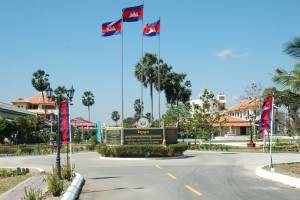
Cambodia today
Let’s look at Cambodia today. CIAP helped set up the Cambodian Agricultural Research and Development Institute (CARDI), founded in August 1999. [See Rice and the river: Cambodia ushers in new era.] We did that very early, and then we worked very closely to build up national capacity from scratch—physical infrastructure as well as the human resources to go with it. With support from the AusAid, we were able to send quite a large number of students for advanced education to do master’s and PhDs, mostly in Australia; some of them did it here in the Philippines as well.
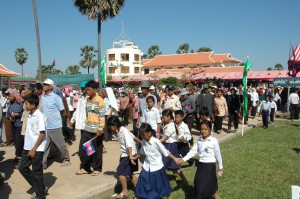
To this day, if you go and look at the organizational chart of CARDI over the last several years, the people who are running the organization, the current director, for example, Ouk Makara (in photo with Dr. Denning at CARDI), got their PhDs in Australia. He’s one of our counterparts, one of the trainees. Many others in the organization, leading in breeding, soils, entomology and so on, all came through this IRRI partnership that was supported mainly by Australia over a period of a couple of decades.
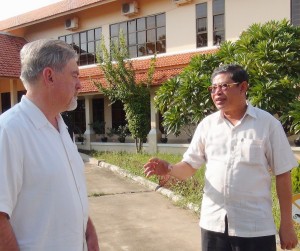
So that’s the history in terms of what we did. I talked a lot about varieties, but we worked on agronomy. We als o worked on integrated pest management, postharvest technology, mechanization—all of these things were going on at the same time over long periods.
When we went there in January 1986, the production in the country was around 2 million tons (Figure 1). The average yield was just over 1 ton per hectare. Looking at it today, almost 30 years later, total production in the country is around 9 million tons (Figure 1). The country is an exporter again. In fact, for the last several years, Cambodia has been exporting somewhere around 800,000 to a little over 1 million tons per year. They really developed their export of rice as a source of income. The area has gone back to about the level before the war from about 2 ½ million hectares, having gone down to half a million, now back up to 3 million hectares. So the area hasn’t greatly expanded.
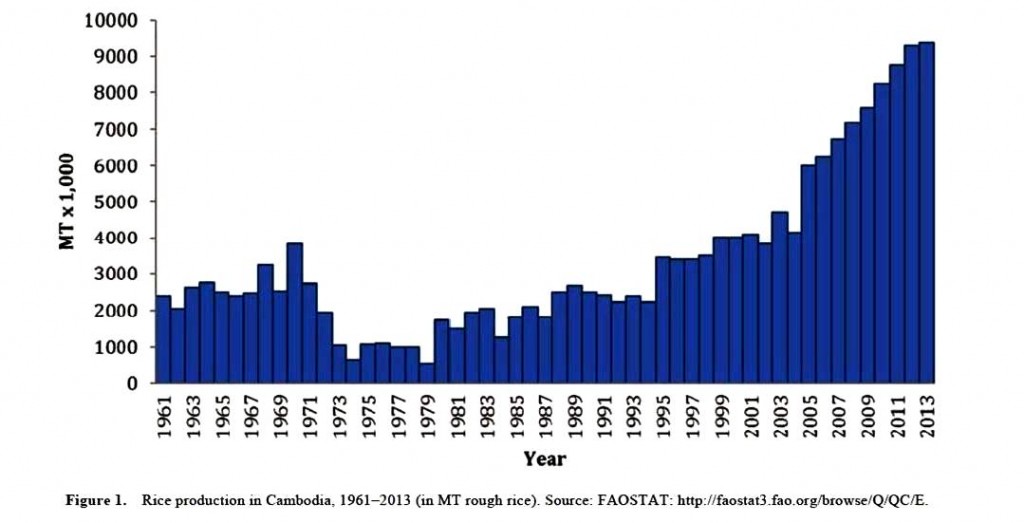 Much of the improvement has come through yield increases. So, the yield is now around 3 tons per hectare, which isn’t as good as Vietnam or Indonesia, but you’ve got to remember that, still, the country is largely rainfed. Irrigation has expanded. Investments have expanded. But to be able to get 3 tons per hectare on land that is principally rainfed means that a lot has gone into the improvement of crop production. So, I think Cambodia itself is a great credit to IRRI and, in
Much of the improvement has come through yield increases. So, the yield is now around 3 tons per hectare, which isn’t as good as Vietnam or Indonesia, but you’ve got to remember that, still, the country is largely rainfed. Irrigation has expanded. Investments have expanded. But to be able to get 3 tons per hectare on land that is principally rainfed means that a lot has gone into the improvement of crop production. So, I think Cambodia itself is a great credit to IRRI and, in
itially, the vision of Director General Swaminathan; and consistent long-term partnership with that country through thick and thin. For the most part, Australia was the big supporter, but we were able over the years to diversify that level of support.
One of the key successes is we’ve been able to connect Cambodian scientists with scientists in other countries. We’ve always wanted that. We did not want them to be dependent only on IRRI. We wanted them to be able to work with the Thais, with the Lao, with the Vietnamese, with the Indonesians, with the Chinese again, to build collegial relationships which w
ould give strength to the national research system. So that’s basically the Cambodia story.
Applying lessons from the Cambodian experience elsewhere
I think Cambodia is a very good lesson, which by the way, I’ve shared with a number of other colleagues in other parts of the world as far away as Africa. When we see countries coming out of conflict, I think we can take some lessons from what happened in Cambodia. I’ve used some similar approaches in East Timor (Timor Leste), again, a country coming out of conflict. It’s not a predominantly rice-growing area, but I think the general principle when you come out of conflict is you often have minimal infrastructure, you have very limited human resources, and you often need to borrow technology and build up research capacity yourself. So we’ve looked at that in Timor Leste.
We’ve also looked to do this in Mozambique. I know IRRI is now working in Mozambique, I think doing a very similar approach—improving varieties, building national capacity, and strengthening national institutions. It’s a good model and I think it should be shared more widely. It’s going to be probably very relevant to Afghanistan and perhaps some other parts of the world in the years ahead—and not just for rice, but for any crop.
For additional background on the Cambodian experience, see: Towering legacies; The Burning of the Rice: A Cambodian Success Story by Don Puckridge; Fostering international collaboration, for food security and sustainable development: a personal perspective of M.S. Swaminathan’s vision, impact, and legacy by Glenn Denning; Rice production in Cambodia by Harry Nesbitt; and The soils used for rice production in Cambodia by Peter White, Thomas Oberthür, and Pheav Sovuthy.
_____________________
Gene Hettel is editor-in-chief of Rice Today.




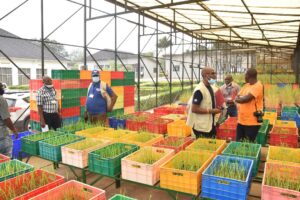


Nice article ..I really appreciate the author from providing information. India also one of the best country for producing rice .complete information at htpp://asiafarming.com